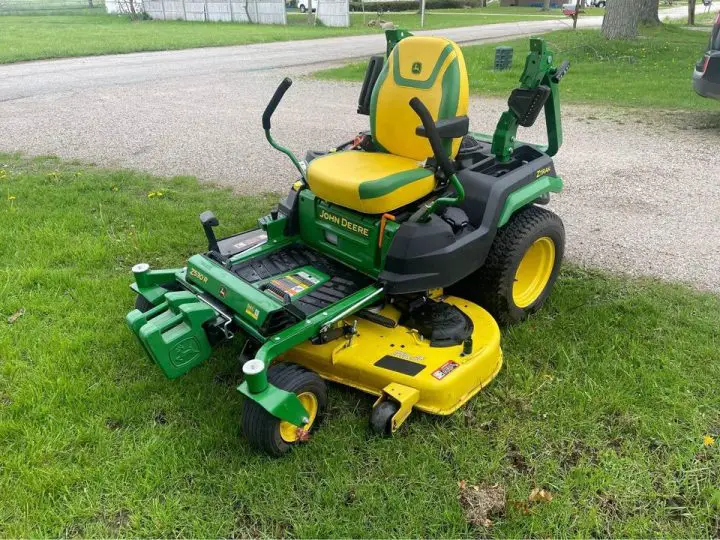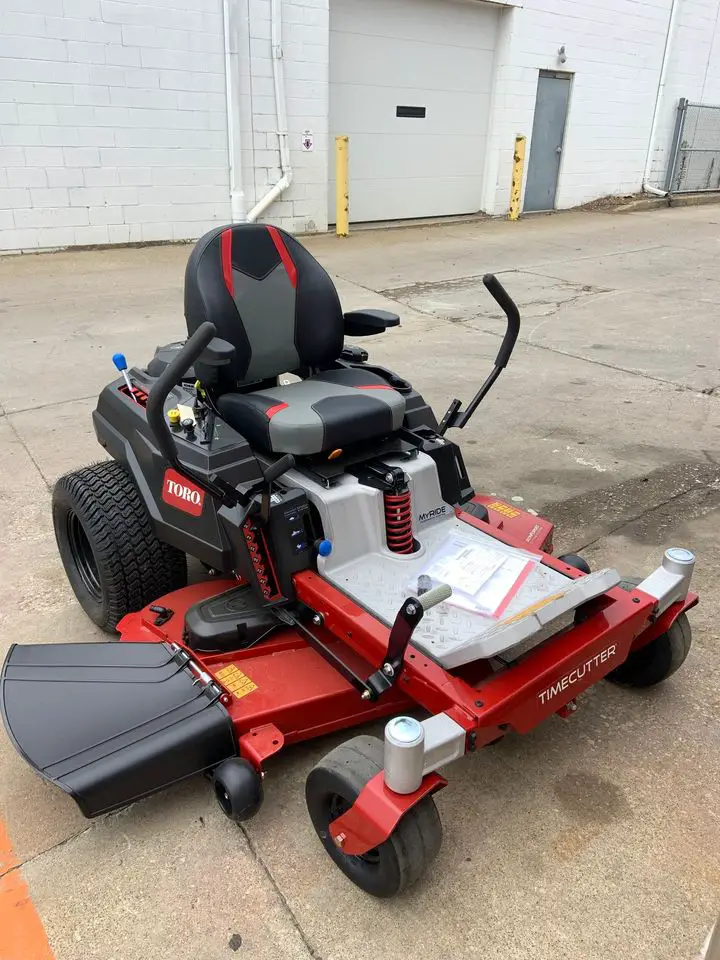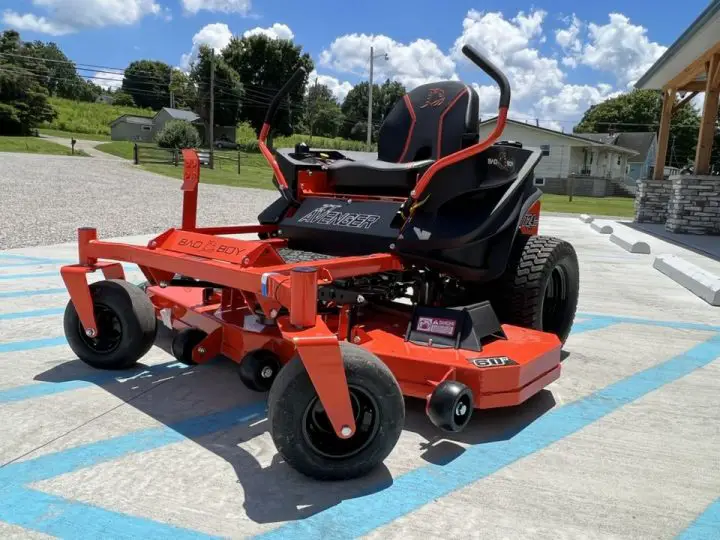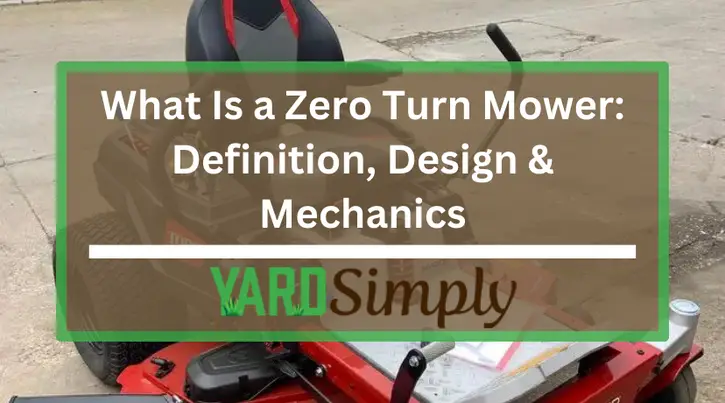As a seasoned landscaping expert with over a decade of experience in lawn maintenance, I’ve developed a deep understanding of various lawn care tools, especially zero turn mowers.
These mowers, distinguished by their unparalleled maneuverability and efficiency, represent a significant advancement in lawn care technology.
My aim is to provide you with concise, expert insights into what a zero turn mower is and why it might be a game-changer for your lawn care routine.
With my practical knowledge and hands-on experience, I assure you a comprehensive guide that will not only inform but also empower you to make the best decision for your lawn maintenance needs.
Let’s dive into understanding the mechanics, benefits, and potential of zero turn mowers.
Quick Summary
- A zero turn mower is a highly maneuverable riding lawn mower with a zero-degree turning radius, enabling precise and efficient lawn cutting.
- Originating in the 1960s, the zero turn mower was innovated by John Regier, who adapted aerospace technology for lawn care.
- Studies suggest zero turn mowers can reduce lawn maintenance time by up to 50% compared to traditional riding mowers.
- Personally, I find that investing in a zero turn mower is a wise decision for efficient and enjoyable lawn maintenance.
Definition of a Zero Turn Mower

A zero turn mower, characterized by its exceptional maneuverability, can pivot on its own axis, allowing for precise cutting around obstacles and efficient mowing in large areas. What sets it apart is its steering mechanism.
Unlike traditional riding mowers steered with a wheel, I’m maneuvering this beast with two levers that control the rear wheels independently.
This means if I push one lever forward and pull the other back, I’ll spin right around with zero radius – hence the name.
Learn More: The Ultimate Guide To Lawn Mowers
Brief History and Evolution
The origins and evolution of zero turn mowers reveals a fascinating journey of innovation in grass cutting technology. The inception of the zero turn mower can be traced back to the 1960s, a brainchild of John Regier.
Regier, working for Hesston Corporation, was inspired by the swather’s belt-and-pulley mechanism used in agriculture.
He ingeniously adapted this design, originally from the aerospace industry, to create a lawn mower that could pivot without moving forward, allowing for sharp turns and easy maneuvering around obstacles.
This was a significant departure from the traditional steering systems used in lawn mowers at the time.
Regier’s invention led to the creation of the first twin-lever zero turn lawn mower, which had no steering wheel and turned on a zero degree radius using two independent drive levers.
This technology, though initially met with skepticism due to its novelty, eventually gained popularity and was a turning point in lawn mower design.
The term “zero turn radius” was later coined in 1974 by the Dixon company as they entered the mower market. Over the years, these mowers have undergone continuous evolution.
Manufacturers have refined Regier’s original designs to enhance performance, comfort, and durability. The advancements in zero turn mowers have led to the introduction of models with powerful engines, ergonomic controls, and advanced adjustable cutting decks.
These features have made zero turn mowers a favorite among both commercial landscapers and homeowners who seek precision and efficiency in lawn maintenance.
Design and Mechanics of Zero Turn Mowers
Understanding these aspects is key to appreciating the efficiency and maneuverability that zero turn mowers bring to lawn maintenance.
Unique Design Features

Zero turn mowers boast an innovative steering mechanism that allows for precise maneuvering around the tightest of corners. Unlike traditional riders, these mowers pivot at zero radius, thanks to their independently controlled rear wheels.
I can simply push one lever forward and pull the other back, and the machine spins on a dime.
Their decks also stand out; they’re typically mounted in front, giving me an unobstructed view and the ability to cut grass right up to edges and obstacles.
This design means I’m not just mowing faster, but also more efficiently, reducing the need for follow-up trimming.
Moreover, these mowers often feature powerful engines and wide cutting paths. I can tackle large, open spaces in a fraction of the time it would take with a conventional mower.
It’s not just a tool; it’s an impressive piece of engineering that transforms lawn care into an art.
Engine Mounting
Zero turn mowers are characterized by two primary design variations: Mid Mount and Out Front models, each tailored to different mowing needs and environments.
Mid Mount zero turn mowers feature the mowing deck suspended under a four-wheel chassis. This design incorporates front caster wheels and rear drive wheels, making it highly effective for general lawn mowing tasks.
The design ensures stability and agility, especially in lawns with a variety of obstacles or uneven terrain.
How Zero Turn Mowers Operate
Each lever is connected to a hydraulic speed control system for one of the rear drive wheels.
When I push both levers forward, the mower moves straight ahead. Pulling them back causes it to reverse. If I push one lever more than the other, the mower turns in the direction of the lesser-pushed lever.
The true agility shows when I push one forward and pull the other back, making the mower pivot around one wheel, effectively turning on a dime.
Advantages of the Zero Turn Mechanism
The most striking benefit is the exceptional maneuverability. I can navigate around obstacles like trees and flower beds with ease, thanks to the mower’s ability to rotate on its own axis. This reduces the time I spend trimming edges separately.
Moreover, the increased control and speed allow me to finish mowing much faster compared to traditional mowers. I also appreciate the reduced physical effort; there’s no need to push or wrestle with the machine.
The design translates to a smoother ride, too, which is less tiring and more enjoyable.
Comparing Zero Turn Mowers with Traditional Lawn Mowers
Now, let’s turn our attention to how zero turn mowers stack up against traditional lawn mowers.
I’ll explore their maneuverability, assess which mower type is better for different lawn sizes, and compare their costs.
Understanding these differences is crucial when deciding which mower is the best investment for your lawn care needs.
Learn More: Zero Turn vs Riding Mower: Right Ride for Your Lawn
Maneuverability and Efficiency
When it comes to the art of lawn maintenance, zero turn mowers outshine traditional lawn mowers in both maneuverability and efficiency. I’ve found their ability to pivot on a dime invaluable, especially around intricate garden beds and obstacles.
Unlike a conventional riding mower that requires ample space for turning, I can spin a zero turn in place, slashing the time I spend on awkward reversing and repositioning.
Suitability for Different Lawn Sizes
Zero turn mowers, with their superior agility, are particularly well-suited for large lawns. I’ve found that the zero turn’s ability to swiftly pivot and handle wide, open areas saves me a ton of time on my one-acre plot.
The speed and precision mean I’m done mowing in a breeze, without the back-and-forth I used to do with my old push mower.
On the flip side, I wouldn’t recommend a zero turn for a tiny, obstacle-filled yard. In those cases, a traditional mower’s smaller size and ease of handling in tight spots can’t be beaten. It’s all about matching the mower to the space you’ve got.
Cost Comparison
While the right mower can make lawn care a breeze, it’s essential to consider the investment, as zero turn mowers generally come with a higher price tag compared to traditional lawn mowers.
I’ve found that the cost difference can be quite significant. A standard push mower might set you back a few hundred dollars, whereas a basic zero turn model starts in the lower thousands.
Read More: Best Zero Turn Mowers Under $3000
Types of Zero Turn Mowers

As we explore zero turn mowers, it’s important to note that they come in two main categories: residential and commercial.
I’ll break down the key features and specifications that set these types apart, helping you understand which might best suit your needs.
Whether you’re maintaining a small backyard or managing large landscapes, there’s a zero turn mower designed for the task.
Residential Zero Turn Mowers
Diving into the realm of residential zero turn mowers, these agile machines cater to homeowners seeking efficiency and precision in lawn maintenance.
I’ve learned that residential models are generally smaller and less powerful than their commercial counterparts, yet they’re perfect for navigating through tight spaces and around obstacles in your yard.
They’re equipped with cutting decks that range in size, but they typically fall between 30 and 60 inches, which is ideal for most private lawns.
Commercial Zero Turn Mowers
Shifting gears to commercial zero turn mowers, these robust workhorses are built to handle the rigorous demands of professional landscaping with larger cutting decks, more powerful engines, and enhanced durability.
I’m talking about machines that are designed for daily, heavy-duty use. They’ve got the muscle to mow large areas quickly, saving me precious time on big projects.
Their cutting decks often span over 60 inches, which means I can tackle vast expanses of grass with fewer passes.
What’s more, they come with high-performance features like reinforced frames, commercial-grade transmissions, and advanced comfort options to keep me going all day.
Our Verdict
My time with the good zero turn mower has truly revolutionized the way I approach lawn care. Its ability to navigate effortlessly and precisely around obstacles has not only saved me time but also made the task more enjoyable.
From its historical roots in the 1960s to the advanced models available today, the evolution of zero turn mowers is impressive.
For anyone looking to efficiently maintain their lawn with less effort and more satisfaction, a zero turn mower is an excellent choice. In short, it’s a game-changer for any lawn enthusiast.
Frequently Asked Questions
How does the maintenance schedule of a zero turn mower differ from that of a traditional lawn mower?
I maintain my mower more frequently due to its complex steering and transmission system, which differs from traditional mowers that typically require simpler, less frequent upkeep.
Can zero turn mowers be used on all types of terrain, or are they limited to flat landscapes?
I’ve found that zero turn mowers aren’t great for all terrains; they excel on flat landscapes but can struggle on steep slopes or uneven ground, where a traditional mower might be better.
What safety precautions should be taken when operating a zero turn mower on a slope?
When mowing on a slope, I always wear a seatbelt, keep a steady pace, and avoid abrupt turns to prevent tipping. I also don’t mow wet grass to reduce slipping risks.
How environmentally friendly are zero turn mowers compared to traditional lawn mowers, especially in terms of emissions and fuel efficiency?
I’ve learned that zero turn mowers aren’t typically more eco-friendly than traditional ones; they often have similar emissions and fuel efficiency, though electric models can offer a greener alternative.
Are there autonomous or robotic zero turn mowers available for those who want a hands-free mowing experience?
Yes, I’ve seen autonomous zero turn mowers that offer a hands-free mowing experience. They use GPS and sensors to navigate, ensuring efficient lawn maintenance without needing me to steer them.


